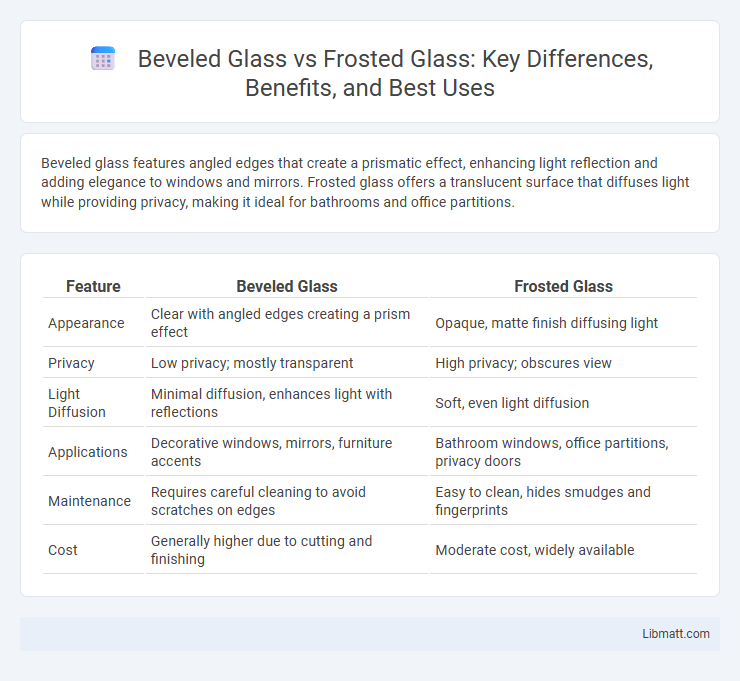Beveled glass features angled edges that create a prismatic effect, enhancing light reflection and adding elegance to windows and mirrors. Frosted glass offers a translucent surface that diffuses light while providing privacy, making it ideal for bathrooms and office partitions.
Table of Comparison
| Feature | Beveled Glass | Frosted Glass |
|---|---|---|
| Appearance | Clear with angled edges creating a prism effect | Opaque, matte finish diffusing light |
| Privacy | Low privacy; mostly transparent | High privacy; obscures view |
| Light Diffusion | Minimal diffusion, enhances light with reflections | Soft, even light diffusion |
| Applications | Decorative windows, mirrors, furniture accents | Bathroom windows, office partitions, privacy doors |
| Maintenance | Requires careful cleaning to avoid scratches on edges | Easy to clean, hides smudges and fingerprints |
| Cost | Generally higher due to cutting and finishing | Moderate cost, widely available |
Introduction to Beveled and Frosted Glass
Beveled glass features angled edges that create a prism-like effect, enhancing light reflection and adding a decorative dimension to windows and mirrors. Frosted glass undergoes a surface treatment, such as sandblasting or acid etching, to produce a translucent, matte finish that ensures privacy while allowing natural light to diffuse through. Both types serve distinct purposes in interior design, with beveled glass emphasizing elegance and detail, whereas frosted glass prioritizes privacy and soft illumination.
What is Beveled Glass?
Beveled glass features edges that are cut and polished at an angle, creating a prism effect that enhances light reflection and adds a decorative touch to windows, mirrors, and furniture. This type of glass offers a distinctive, elegant appearance by framing clear glass panels with angled edges that catch and refract light. Your choice of beveled glass can elevate interior design by introducing subtle depth and sophistication compared to the diffused, matte finish typical of frosted glass.
What is Frosted Glass?
Frosted glass features a matte, opaque surface created by sandblasting or acid etching, which diffuses light to provide privacy while maintaining brightness. This type of glass is ideal for spaces where obscured visibility is essential, such as bathroom windows or office partitions. Your choice of frosted glass enhances both aesthetic appeal and functional privacy without sacrificing natural light.
Key Differences Between Beveled and Frosted Glass
Beveled glass features angled edges that create a prismatic effect, enhancing light reflection and adding dimensionality, whereas frosted glass is treated with acid or sandblasting to produce a translucent surface that diffuses light and ensures privacy. Beveled glass is commonly used for decorative purposes in windows, mirrors, and tabletops, while frosted glass is preferred in bathrooms, office partitions, and shower enclosures for privacy without sacrificing natural light. The key difference lies in their function and aesthetic impact: beveled glass emphasizes visual elegance and light play, whereas frosted glass prioritizes privacy and soft, diffused illumination.
Aesthetic Appeal: Beveled vs. Frosted Glass
Beveled glass enhances aesthetic appeal with its polished edges that create prism-like light reflections, offering a classic and elegant look ideal for decorative windows and mirrors. Frosted glass provides a modern, sleek appearance by diffusing light and obscuring visibility, perfect for privacy in bathrooms and office partitions. Choosing between beveled and frosted glass depends on the desired visual effect--ornate brilliance versus subtle sophistication.
Privacy Considerations
Beveled glass offers a decorative edge with limited privacy as it remains mostly transparent, allowing clear visibility through the glass. Frosted glass provides superior privacy by diffusing light and obscuring visibility, making it ideal for bathrooms, offices, and private rooms. When privacy is a priority, frosted glass is the preferred choice due to its effective light diffusion and opacity.
Light Transmission and Illumination
Beveled glass enhances light transmission by refracting and reflecting light through its angled edges, creating brilliant illumination and a prismatic effect that brightens your space. Frosted glass diffuses light softly, reducing glare while maintaining privacy, resulting in a gentle, even illumination ideal for ambient settings. Choosing between beveled and frosted glass depends on whether you prefer sharp, sparkling light or muted, diffused brightness for your environment.
Common Applications for Beveled and Frosted Glass
Beveled glass is commonly used in decorative applications such as cabinet doors, mirrors, and windows to add elegance and dimension through its angled edges. Frosted glass is frequently applied in bathroom windows, office partitions, and shower enclosures to provide privacy while allowing light to pass through. Your choice between beveled and frosted glass depends on whether you prioritize decorative appeal or functional privacy.
Maintenance and Durability
Beveled glass features angled edges that require gentle cleaning to prevent chipping, while frosted glass has a textured surface that can mask fingerprints and smudges, reducing the need for frequent maintenance. Both types offer good durability, but beveled glass tends to be more prone to edge damage due to its intricate design, whereas frosted glass, often made through acid etching or sandblasting, maintains strength while resisting minor scratches. Your choice between the two should consider how much upkeep and long-lasting wear you prioritize in your space.
Choosing the Right Glass for Your Space
Beveled glass features angled edges that create a prism effect, adding elegance and depth to entryways, windows, and decorative panels, making it ideal for enhancing natural light and visual interest. Frosted glass offers privacy and a soft, diffused appearance, perfect for bathrooms, office partitions, and shower doors where light transmission needs to be balanced with discretion. Selecting the right glass depends on whether the priority is decorative detail with light refracting qualities or functional opacity for privacy and a modern aesthetic.
Beveled glass vs frosted glass Infographic

 libmatt.com
libmatt.com